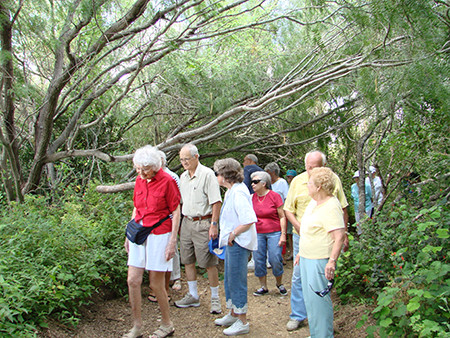 A big draw to Deep South Texas is the nature sites and its many birds and butterflies. South Texas is home to numerous species of birds and butterflies that aren’t found anywhere else. South Texas also exists on a huge migratory corridor that attracts visitors from all over the world. Because of this, there are nature parks throughout the Rio Grande Valley and there are different types of festivals held throughout the year to celebrate the nature, birds and butterflies that call the RGV home, even if temporarily.
A big draw to Deep South Texas is the nature sites and its many birds and butterflies. South Texas is home to numerous species of birds and butterflies that aren’t found anywhere else. South Texas also exists on a huge migratory corridor that attracts visitors from all over the world. Because of this, there are nature parks throughout the Rio Grande Valley and there are different types of festivals held throughout the year to celebrate the nature, birds and butterflies that call the RGV home, even if temporarily.
There is group of nature parks that are organized under the World Birding Center. Parks under that umbrella are Bentsen-Rio Grande Valley in Mission, Edinburg Scenic Wetlands, Estero Llano Grande in Weslaco, Harlingen Arroyo Colorado, the Old Hidalgo Pumphouse, Quinta Mazatlan in McAllen, Resaca del la Palma in Brownsville, Roma Bluffs, and South Padre Island Birding and Nature Center. Information about all the parks can be found at www.theworldbirdingcenter.org.
Other parks include nature centers in McAllen and Mission and Laguna Atascosa. There are also wildlife refuges like Santa Ana and Laguna Atascosa. The Valley even has a butterfly park, the National Butterfly Center, in Mission. Although, not mentioned in detail in this, the RGV also has Battlefield landmarks that have been made into parks with walking trails and gardens, and other historical sites that have been beautified to attract the abundant wildlife in the area. You can find out more about some of these sites, and others, in our Rio Grande Valley Visitors Guide that can be found in our digital editions on our website – www.wintertexantimes.com.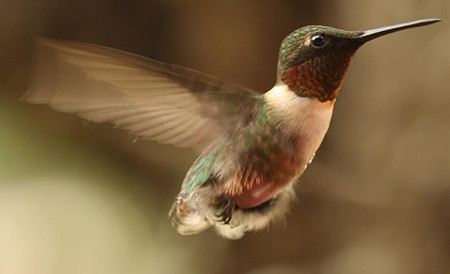
These are just a few of the dedicated nature sites that can be found across the RGV. For now, we will highlight the World Birding Center parks.
Each site of the World Birding Center has its own attractions for both the first-time visitor and expert birder. More than 500 bird species make these parks, and area, a not-to-be missed nature destination. The nine sites are located along 120 miles of river road from South Padre Island to Roma. Habitats range from dry chaparral brush and verdant riverside thickets to freshwater marshes and coastal wetlands.
Bentsen-Rio Grande Valley State Park has a visitor’s center that is surrounded by butterfly gardens and hummingbird feeders. Visitors can take a transportation shuttle, ride bikes or walk through the park. A two-story observation tower gives visitors a bird’s-eye view of the canopy as well as a peek into Mexico. Two enclosed bird blinds, a birding wall and several water features allow visitors to see birds up close and watch their behaviors. Ten bird feeding stations are stocked from November through March and over seven miles of trails offer a variety of opportunities to encounter wildlife inside the park.
Green Jays and plain Chachalacas congregate regularly at the bird feeding stations. Other birds to look for include the Gray Hawk, White-tipped Dove, Groove-billed Ani, Ringed Kingfisher, Northern Beardless-Tyrannulet, Clay-colored Thrush, Long-billed Thrasher and Altamira Oriole. Popular during the spring and fall are virtual clouds of migrating Broad-winged and Swainson’s Hawks.
The park also offers meeting rooms, primitive tent camping sites, bike and binocular rentals and guided nature tours. As with all of the World Birding Center Sites, yearly programs and a full calendar can be found on their website.
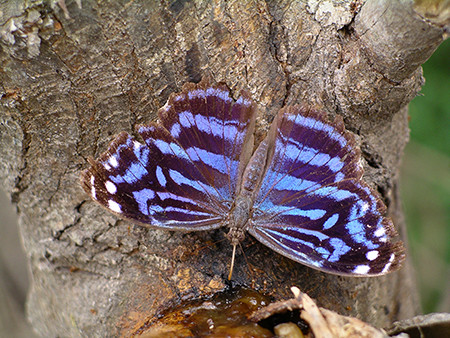 The Edinburg Scenic Wetlands offers 40 acres of park with winding paths and waterside observation platforms. Educational exhibits, computer programs, telescopes and interpretive audio stations allow for close-up inspection of its various inhabitants. While floor-to-ceiling windows ensure watchable wildlife in every season.
The Edinburg Scenic Wetlands offers 40 acres of park with winding paths and waterside observation platforms. Educational exhibits, computer programs, telescopes and interpretive audio stations allow for close-up inspection of its various inhabitants. While floor-to-ceiling windows ensure watchable wildlife in every season.
Birds to watch for include waterfowl and shorebirds like the Green Kingfisher, Least Grebe and American Avocet that can be viewed from platforms overlooking peaceful freshwater lagoons. At least 13 species of ducks flock to the park in the winter months.
The park offers walking trails, nature tours, backyard habitat tours and classes.
Harlingen Arroyo Colorado consists of Texas Ebony woodlands and Harlingen Thicket – over 90 acres of trees, shrubs and flowering plants that support a variety of wildlife and a refuge for birds and other creatures. While being close to major highways and an airport, the area remains a quiet wooded retreat from the hustle and bustle of urban life. Work is currently underway on a visitors’ center that will include a gift shop, observation tower, meeting rooms and enclosed viewing areas.
Currently there are extensive trails where visitors can find birds such as the Green and Ringed Kingfisher, Common Pauraque, Groove-billed Ani, Long-billed Thrasher and Olive Sparrow. Endangered Red-crowned Parrots are also found at the park.
The Old Hidalgo Pumphouse serves as a museum retelling the Magic Valley’s early 29th century transition into an agricultural powerhouse, but also embraces nature conservation with planned hummingbird gardens, a bike trail and more. The land consists of native trees, shrubs and flowers including Huisache, Texas Ebony, Anacua and Mesquite.
Tropical Kingfishers, Great Kiskadees, Green Jays, Clay-colored Robin, Altamira Oriole and others can be found here. In the winter, colorful warblers, kinglets and gnatcatchers can be found. Visitors on the bike trial have seen Brown and White Pelicans, Cormorant Ducks, Grey Hawks, Turkey Vultures, American Coots and other waterfowl.
Quinta Mazatlan is a 1930’s historic Spanish Revival adobe hacienda surrounded by lush tropical landscaping and native woodland. An urban oasis with quiet trails that wind through 15 acres of birding habitat, is close to airports and hotels.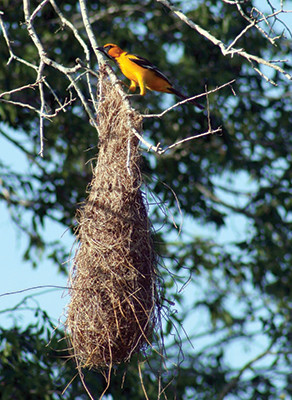
The wild Tamaulipan thorn forest has been enhanced with water and bird feeding stations to attract more wildlife. Many Valley specialties such as the Plain Chachalacas, Common Pauraques, Clay-colored Thrushes, Green Jays, Buff-bellied Hummingbirds and Olive Sparrows can be seen regularly along with occasional tropical migrants.
The park also features regular talks, classes, tours, gardens, an amphitheater, bronze sculptures, and more.
Resaca de la Palma boasts the largest tract of native habitat in the World Birding Center network. Its 1,200 semi-tropical acres provide a quiet retreat from the hustle and bustle of an international urban center only a few miles away. The park is home to abandoned coils of riverbed, known locally as resacas. These resacas create wildlife attracting ponds when full. Along the natural levees of these shallow ponds are dense stands of banco woodlands and marsh vegetation.
Resaca de la Palma promises to be an especially rich birding environment. Colorful neo-tropical and nearctic migrants — like the Summer Tanager, American Redstart, and Yellow-breasted Chat – have been noted here more often and in higher numbers. When resaca levels are controlled for the benefit of wildlife, species like the Least Grebe, Black-bellied Whistling Duck, Purple Gallinule and various herons, as well as migrating waterfowl in their seasons, should also congregate here. The property’s dense ground-level vegetation is especially attractive to species like the Olive Sparrow, Long-billed Thrasher and White-eyed Vireo.
The park also has six miles of trails, four observation decks, a butterfly garden, tram tours and bicycle trails.
History and nature meet at Roma Bluffs that is on the old plaza of a once-thriving steamboat port. A narrow band of river woodland at Roma Bluffs hints at the vast acreage in ash, black willow and sugar hackberry found elsewhere on nearby government refuges north of the Rio Grande. Stands of thorny Texas Ebony dominate some tracts, while drier upland sites feature colorful mesquite-prickly pear brush.
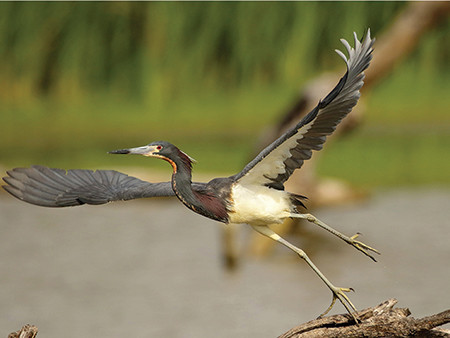 River woodlands like those at WBC Roma Bluffs provide essential shelter for the kinds of neo-tropical birds found nowhere else in the United States but extreme south Texas. Starr County is especially known for the Red-billed Pigeon, Audubon’s Oriole, Brown Jay and White-collared Seedeater not seen farther downstream. Three kinds of Kingfishers find the Rio Grande attractive, and along with most “Valley specialties” like the Great Kiskadee and Plain Chachalaca, the area also is known as a great place to see Altamira Orioles and Clay-colored Robins in abundance.
River woodlands like those at WBC Roma Bluffs provide essential shelter for the kinds of neo-tropical birds found nowhere else in the United States but extreme south Texas. Starr County is especially known for the Red-billed Pigeon, Audubon’s Oriole, Brown Jay and White-collared Seedeater not seen farther downstream. Three kinds of Kingfishers find the Rio Grande attractive, and along with most “Valley specialties” like the Great Kiskadee and Plain Chachalaca, the area also is known as a great place to see Altamira Orioles and Clay-colored Robins in abundance.
The overlook offers a magnificent view of the river, island and woodlands below, as well as views across the border to the Mexican town of Miguel Aleman.
The park also features an outdoor amphitheater, an 1881 National Historic Landmark building, history tours, walking trails, bird tours, classes and exhibits.
Estero Llano Grande is the geographic center of the WBC network. Sitting in Weslaco, the park attracts a spectacular array of South Texas wildlife with its varied landscape of shallow lake, woodlands and thorn forest. Even beginning birders and nature lovers will enjoy exploring the 230 plus-acre refuge.
Estero Llano Grande has a well-deserved reputation as a can’t-miss birding destination. In late summer, when water is at a premium, hundreds of waders and shorebirds flock here, including the endangered Wood Stork, along with colorful coastal species like the Roseate Spoonbill and Ibis. Migrating waterfowl also make a beeline for the park’s narrow, shallow lake. Elsewhere, woodland & thorn scrub harbor all the must-see Valley specialties such as the Groove-billed Ani and Altamira Oriole. Adding spice to this mix, visitors may even spot rare Red-crowned Parrots and Green Parakeets.
Also, at the park is a viewing deck, boardwalks, observation deck, classroom, and over three miles of trails.
At the southern tip of the RGV, you can find the South Padre Island Nature and Birding Center. On its 50 acres, the center presents a microcosm of the rich habitats such as dune meadows, salt march and intertidal flats, as well as thickets of native shrubs and trees.
South Padre Island is a crucial first landfall – a lifesaver – for birds making an arduous cross-Gulf migration from Southern Mexico and northern Central America. Especially after a spring storm, wooded lots of the island teem with an eye-popping rainbow of warblers, tanagers, orioles and thrushes. Wetlands harbor a range of shorebirds and waterfowl, while endangered species such as the Brown Pelican, Piping Plover and Peregrine Falcon may be found here as well.
The center offers more than 3,300 linear feet of boardwalk, five bird blinds and a five-story tower with views of the Laguna Madre, beaches and dunes of South Padre Island, the Gulf of Mexico and the South Padre Island skyline.
The auditorium features movies while you can also find educational hands-on exhibits and a gift shop.
More information on the World Birding Center parks, their hours, schedules and other information (including what is found here), can be found on their website at www.theworldbirdingcenter.com.
Information on more sites in the Rio Grande Valley can be found in our digital editions on our website at https://www.wintertexantimes.com/online-editions/mobile-home-a-park-directory.html.
Information on the Butterfly center can be found at https://www.nationalbutterflycenter.org/.
Palo Alto Battlefield information can be found at https://www.nps.gov/paal/index.htm. This park is extending its trails to connect to the entire lower Rio Grande Valley.













